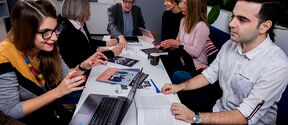WorkPartner robot retired to the Museum of Technology
Nationally, the robot has, for example, been an important reference and has offered an important training environment in the automation development of new generation mobile machines.
Important donation to the museum
The director of the Museum of Technology Marjo Mikkola received the donation on 1 December 2015 from Emeritus Professor Aarne Halme, who was responsible for the whole project.
From the museum's perspective, this is a significant donation for which we are very grateful. As I see it, the museum is now receiving a donation which we may regard as the symbol of the robot era, Mikkola thanked.
Emeritus Professor Aarne Halme and the director of the Museum of Technology Marjo Mikkola signed a contract on the donation.
WorkPartner brings with it to the museum also extensive context data, for example accurate documentation of its development stages and videos as well. The well-detailed documented data on the robot provides added value for the donation itself.
It is not the intention to restore the robot to its operational functionalities, but it will be cleaned and tuned to a good presentation condition.
History of WorkPartner
WorkPartner was a new generation service robot developed in HUT during 1998 – 2006. The design of the robot began under the leadership of Professor Aarne Halme as a part of Tekes' SMART programme in the HUT Automation Technology Laboratory in 1997.
When the SMART programme ended in 2001, the robot development was continued until the end of 2006. Further funding responsibility was carried mainly by Tekes and an industry group, but also the Academy of Finland and the EU supported the development through their own programmes. In the follow-up projects, which were carried out in 2007-2013 during the time of the Finnish Centre of Excellence in Generic Intelligent Machines Research funded by the Academy of Finland, the research was continued with the application of the results in the development of smart mobile work machines.
Originally, the robot was built as an experimental platform for its developers' research activities.
But during its long life span it also played an active role in many other development programmes, both in national and in international ones.
The main goal of the project was to improve basic technology and get all-round experience in the development work of a mechatronic device. A great many solutions, which could be expected to migrate to industrial use within 10 years, were used in the development work, Halme said, explaining the robot's background.
It was intended that WorkPartner would be a different robot, and practical goals were set for it. It was designed to be operational in outdoor conditions, and, as its mobile system, a hybrid of wheels and feet mounted on four legs was chosen; in other words, the robot could use wheels or feet or both together. Another example of hybridisation is the sensing system, which is based on a combination of a camera and distance measurement by laser.
The aim was to produce as versatile research data as possible
The primary goal in the project wasn't providing outright support for product development or bringing a WorkPartner-type robot to commercial markets but providing the industry with as versatile research data as possible about those opportunities that digitalisation in mechanical engineering opens up. In this sense, the development project turned out to be quite successful.
Over the years, the number of people who participated in the research and development work of the WorkPartner robot in the research team under the leadership of Professor Halme was approximately 20 persons all in all. In addition, numerous students' practice studies were carried out around the robot. The number of doctoral theses completed was 4, licentiates numbered 5 and masters 15.
The development program and the results it generated were made fully public and open to all.
The functional goals for all the robot's subsystems were set quite high and the latest technology was used in its structures.
Media interest towards WorkPartner has been great during its entire history. Many TV documents have been made of it, both in Finland and overseas.
Text and photos: Annika Artimo
Read more news

Research Council of Finland establishes a Center of Excellence in Quantum Materials
The Centre, called QMAT, creates new materials to power the quantum technology of coming decades.
Major funding powers development of next-generation machine technology aimed at productivity leap in export sectors
The BEST research project is developing new types of sealing, bearing, and damping technology.
The TAIMI project builds an equal working life – a six-year consortium project seeks solutions to recruitment and skill challenges
Artificial intelligence (AI) is changing skill requirements, the population is aging, and the labor shortage is deepening. Meanwhile, the potential of international experts often remains unused in Finland. These challenges in working life are addressed by the six-year TAIMI project funded by the Strategic Research Council, and implemented by a broad consortium.






